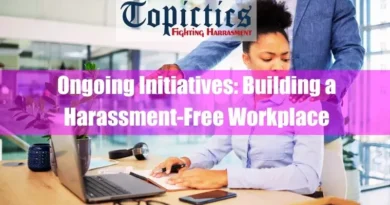Here is an informational table summarizing key takeaways from the article”Explaining Non-verbal Harassment or Abuse”:
| Key Takeaway | Details |
|---|---|
| Definition and Prevalence | Non-verbal harassment involves gestures, images, or physical proximity used to intimidate, threaten, or demean others. It is widespread in workplaces, schools, and online platforms. |
| Types of Non-verbal Harassment | Key forms include gestural harassment (e.g., glaring or mocking), visual harassment (e.g., offensive images or memes), physical proximity (e.g., invading personal space), and cyber cues. |
| Psychological Impact | Non-verbal harassment can cause emotional distress, anxiety, and long-term mental health effects such as chronic stress, depression, and diminished self-worth, affecting personal and professional lives. |
| Legal Protections | Laws like Title VII of the Civil Rights Act and Title IX of the Education Amendments recognize non-verbal harassment as discrimination when it creates a hostile environment, providing legal protection. |
| Workplace Harassment | Common forms include intimidating stares, exclusionary gestures, and subtle behaviors that foster hostile work environments; preventive measures include policies, training, and support. |
| Harassment in Educational Institutions | Non-verbal harassment in schools includes bullying through threatening gestures, exclusionary body language, and offensive visuals; preventive measures include anti-bullying programs and reporting systems. |
| Cultural and Societal Influences | Cultural norms affect perceptions of non-verbal harassment; some gestures may be seen as normal in some cultures but offensive in others, requiring culturally informed prevention strategies. |
| Prevention and Intervention Strategies | Effective strategies include creating clear policies, training on respectful communication, empowering bystanders to intervene, and fostering inclusive environments to reduce harassment. |
Let’s discuss in detail:
I. Introduction
Definition of Non-verbal Harassment or Abuse
Non-verbal harassment or abuse involves the use of non-verbal communication, such as gestures, images, or physical proximity, to threaten, intimidate, or demean another person. Unlike verbal harassment, non-verbal forms are often subtler. Still, they can be just as harmful and pervasive in various settings like workplaces, schools, and online spaces.
Overview of Its Prevalence in Different Settings
Non-verbal harassment is not confined to any one environment. In workplaces, it can manifest through hostile gestures or intimidating stares that create a toxic atmosphere. Schools and colleges are also rife with such behaviors, particularly in the form of bullying through threatening body language or exclusionary gestures. Online platforms, such as social media, have seen a rise in cyber non-verbal harassment, where offensive memes or emojis are used to harm others. A significant portion of workers in the U.S. report harassment at work, often including non-verbal elements like gestures or physical intimidation, showing how widespread this issue is.
II. Types of Non-verbal Harassment or Abuse
Gestural Harassment

Gestural harassment includes aggressive or threatening gestures like pointing, glaring, or mimicking someone to mock them. In the workplace, it may include deliberately intimidating gestures intended to scare or demean someone, such as shaking a fist, especially in a power dynamic between a boss and an employee.
Visual Harassment
Visual harassment involves using offensive images, drawings, or signs that demean or threaten an individual. These images might be posted in a work environment or shared digitally, making the victim feel unwelcome or unsafe. For example, sharing degrading memes targeting a specific group can contribute to an environment of hostility and exclusion.
Physical Proximity
This form of harassment includes invading personal space, blocking someone’s path, or engaging in stalking-like behaviors. In workplaces, hovering over someone’s desk without invitation can be a means to intimidate. Stalking, following, or persistently invading someone’s personal space can make them feel threatened.
Cyber Non-verbal Harassment

In the online world, non-verbal harassment is increasingly taking the form of visual cues like offensive emojis, memes, or videos that carry harmful messages. This form of harassment can be difficult to detect due to the indirect nature of communication on social media platforms but remains just as impactful as physical or gestural abuse.
III. Psychological Impact of Non-verbal Harassment
Emotional Distress and Anxiety
Non-verbal harassment can cause significant emotional distress. Repeated exposure to threatening gestures, unwanted visual material, or physical intimidation often leads to increased anxiety and stress. Victims may develop symptoms of anxiety disorders, experience sleep disturbances, and feel constantly on edge.

Long-term Mental Health Effects
The long-term effects of non-verbal harassment can include chronic stress, depression, and feelings of helplessness. For victims, these experiences can lead to diminished self-worth and the development of mental health conditions, such as stress and anxiety. Continuous exposure to such harassment in the workplace or schools may also result in burnout and withdrawal from social or professional activities.
IV. Legal Definitions and Protections
Overview of Legal Recognition
Non-verbal harassment is legally recognized in many jurisdictions under broader harassment laws. In the U.S., harassment laws fall under anti-discrimination statutes like Title VII of the Civil Rights Act. These laws recognize non-verbal behaviors, such as gestures or visual materials, as forms of harassment when they create a hostile work or learning environment based on characteristics like race, gender, or sexual orientation.
Laws

Title VII of the Civil Rights Act of 1964 (U.S.)
Title VII is a cornerstone federal law that prohibits employment discrimination based on race, color, religion, sex, or national origin.” Courts have interpreted Title VII to encompass both quid pro quo harassment and creating a hostile work environment, although these terms are not explicitly mentioned in the text of the law. While traditionally focused on verbal or physical harassment, courts have recognized that non-verbal conduct—such as lewd gestures or body language—can also violate Title VII if it contributes to creating a discriminatory or hostile work environment.
Title IX of the Education Amendments of 1972
Title IX prohibits sex-based discrimination in any education program or activity receiving federal financial assistance.” This law applies to all public and private elementary and secondary schools, school districts, colleges, and universities. Under Title IX, courts have recognized that quid pro quo harassment, including non-verbal actions such as suggestive gestures or body language, is unlawful when a person in a position of authority demands sexual favors in exchange for academic benefits like grades or scholarships.
Schools must establish procedures for handling non-verbal harassment complaints, including those involving quid pro quo situations. This ensures that students are protected from any form of harassment, verbal, non-verbal, or otherwise, and can pursue their education without facing inappropriate demands for personal favors.
State-Level Anti-Discrimination Laws
Several states have expanded upon Title VII with their own anti-discrimination laws, which also encompass non-verbal quid pro quo harassment. For example:
- California’s Fair Employment and Housing Act (FEHA): This law provides broader protections against harassment than Title VII and explicitly recognizes non-verbal forms of harassment, including gestures and suggestive body language, in both quid pro quo and hostile environment claims.
- New York Human Rights Law: New York’s legislation similarly provides extensive protections against both verbal and non-verbal forms of quid pro quo harassment.
V. Workplace Non-verbal Harassment
Common Examples
Workplace non-verbal harassment can take many forms, from a supervisor staring down an employee to make them feel uncomfortable to colleagues isolating a team member through exclusionary gestures. Studies indicate that workplace harassment is often not limited to overt actions; subtle but consistent behaviors like ignoring someone during meetings or giving threatening looks can create a hostile work environment. These behaviors contribute to reduced employee productivity and mental well-being.
Policies and Preventive Measures
Organizations are increasingly recognizing the need for clear policies to prevent non-verbal harassment. This includes implementing training programs that teach employees about acceptable behavior and non-verbal communication. Companies can create safe channels for reporting non-verbal harassment and support victims. Moreover, fostering an inclusive and respectful work culture is essential to prevent harassment.
VI. Non-verbal Harassment in Educational Institutions

How It Manifests in Schools and Colleges
In educational settings, non-verbal harassment often includes bullying tactics like exclusionary body language or threatening gestures. Students might use physical intimidation or mocking behaviors to isolate peers, and visual harassment through offensive drawings or graffiti can further create a hostile environment. For instance, a group of students might use hand signals or eye rolls to exclude and demean another student.
Preventive Strategies and Reporting Mechanisms
Schools are increasingly focusing on creating anti-bullying programs that address non-verbal harassment. Teachers and administrators should be trained to recognize the signs of non-verbal abuse and intervene before it escalates. Moreover, students should be encouraged to report such behaviors through anonymous reporting systems, which can help in early detection and intervention.
VII. Cultural and Societal Perspectives
How Cultural Norms Influence Perceptions
Cultural perspectives play a significant role in shaping the understanding of non-verbal harassment. In some cultures, gestures like staring or certain hand movements may be seen as normal, while in others, they are considered highly offensive. For example, in some Asian cultures, avoiding eye contact is a sign of respect. In contrast, Western cultures might interpret it as evasiveness or disrespect.
In highly hierarchical cultures, gestures of superiority or exclusion can have more severe social and psychological impacts. Understanding these cultural contexts is essential for developing appropriate prevention and intervention strategies.
VIII. Strategies for Prevention and Intervention
Best Practices for Individuals and Organizations
To combat non-verbal harassment, individuals need to be aware of their body language and the potential impact of their non-verbal communication. Organizations should create clear policies that address non-verbal harassment, ensuring that everyone understands the forms it can take and the consequences of engaging in such behavior. Regular workshops on communication and behavior can also help reduce incidents.
Role of Bystanders
Bystanders play a crucial role in preventing and stopping non-verbal harassment. Encouraging bystanders to intervene or report harassment when they witness it can significantly reduce the prevalence of such behavior. Empowering bystanders through training can make them more confident in recognizing and addressing non-verbal abuse.
IX. Conclusion
Non-verbal harassment is a subtle but harmful form of abuse that affects individuals in various settings, including workplaces, schools, and online environments. The impact on mental health is profound, and legal protections are evolving to address these non-verbal behaviors. Preventive strategies, cultural awareness, and stronger organizational policies can help mitigate the effects and prevalence of non-verbal harassment.









